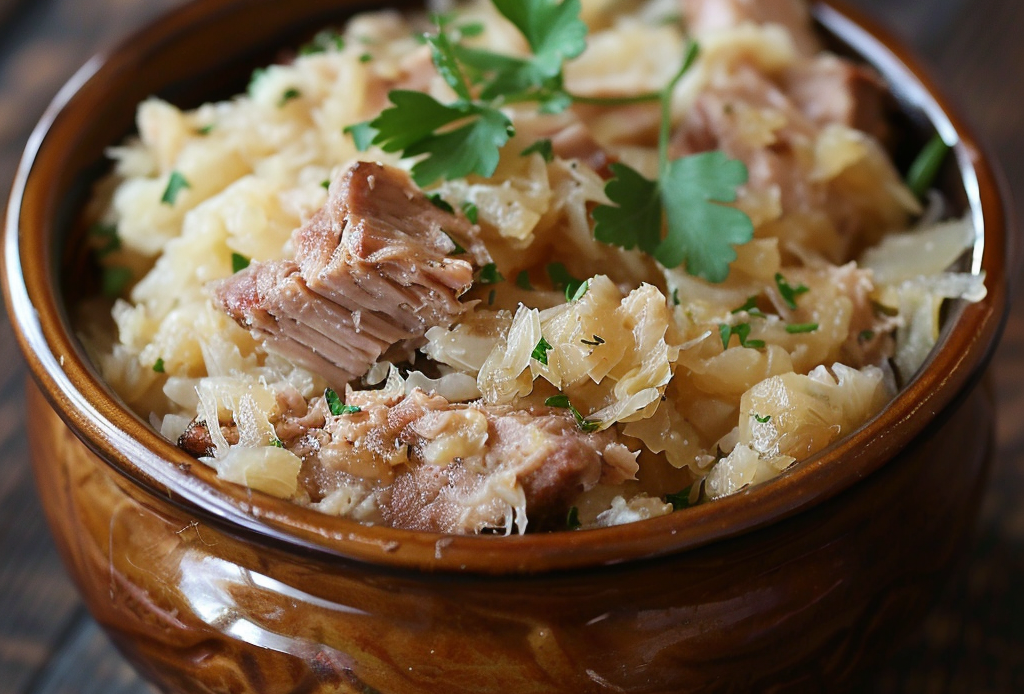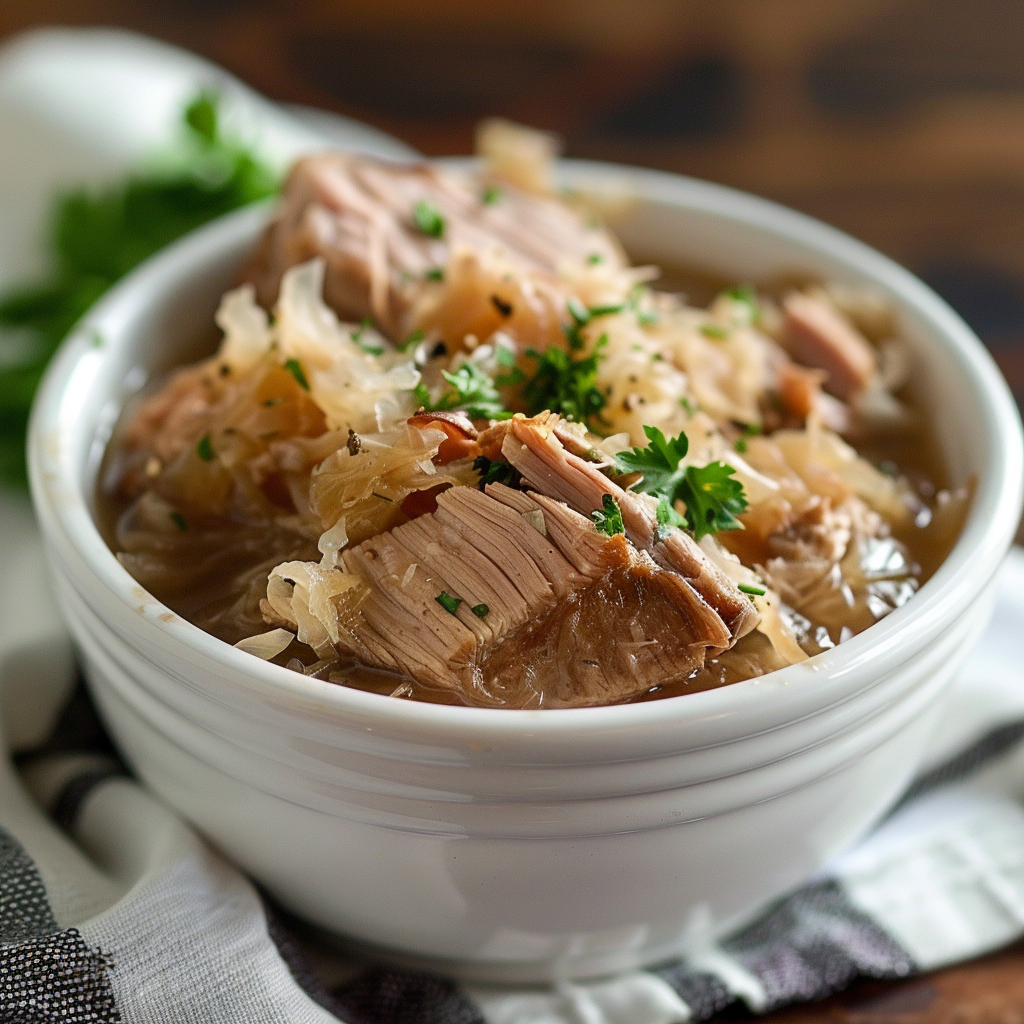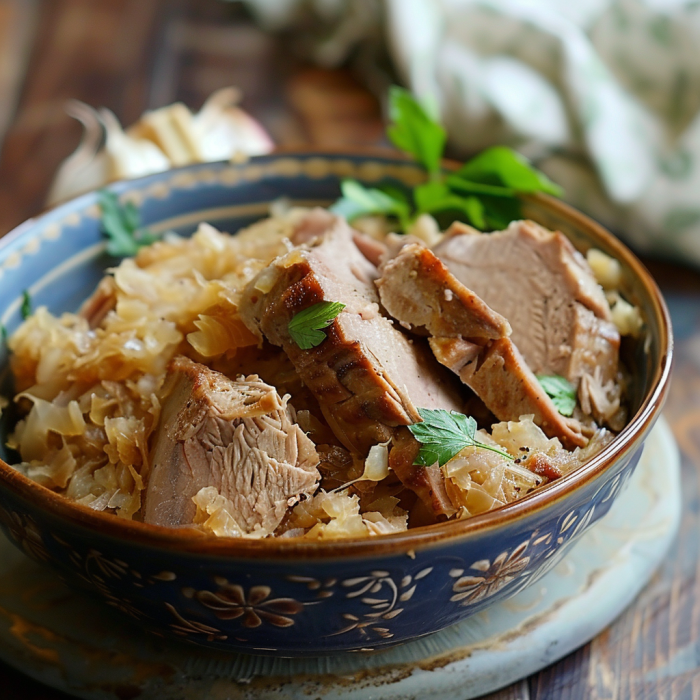
Did you know over 40 million Americans cook slow cooker pork and sauerkraut every year? It’s a favorite in many U.S. homes during winter. This dish combines German traditions with American comfort, loved by many.
Whether you’re new to slow cooking or experienced, this guide helps you make a delicious meal. It shows how to pick the right pork and sauerkraut, and adds secret ingredients for extra flavor. You’ll learn to make a dish that feels like a family recipe, no matter your skill level.
Key Takeaways
- Over 40 million households cook slow cooker pork and sauerkraut yearly, showing its enduring popularity.
- Pork shoulder is the ideal cut for falling-apart tenderness in a crock pot.
- Choosing between jarred or bagged sauerkraut affects the dish’s final taste and texture.
- Secret ingredients like apples or brown sugar balance the dish’s tanginess.
- Proper cooking times ensure pork stays juicy and sauerkraut stays flavorful.
The Rich Tradition of Pork and Sauerkraut in American Cooking
Pork and sauerkraut is more than a meal. It’s a tale of cultural migration and lasting tradition. This dish has centuries of history that have made it a staple in American kitchens.
German and Eastern European Origins
Early German and Eastern European immigrants brought their pork and sauerkraut recipes to the U.S. Germans often used pork shoulder, slow-cooked with caraway seeds. Eastern Europeans, on the other hand, favored pork belly, seasoned with dill and garlic. Here’s how traditions differ:
| Region | Popular Cuts | Signature Spices |
|---|---|---|
| German | Pork shoulder | Caraway seeds, bay leaves |
| Eastern European | Pork belly | Dill, marjoram, juniper berries |
New Year’s Day Good Luck Tradition
In Pennsylvania Dutch communities, serving pork and sauerkraut on New Year’s Day symbolizes wealth. Pigs represent progress (they move forward), and sauerkraut’s coiled leaves mirror coins.
This tradition remains strong in states like Pennsylvania and Ohio. Families still follow this ritual.
Why This Dish Became an American Comfort Food
Its rise to comfort food status comes from:
- Availability of ingredients like cured pork
- Slow-cooking aligning with busy lifestyles
- Warm, savory flavors evoking nostalgia
Today, pork and sauerkraut recipes adapt to modern tastes while honoring their roots. You’ll find this dish in family cookbooks and farm-to-table restaurants alike.
Essential Ingredients for Perfect Slow Cooker Pork and Sauerkraut
To make a delicious slow cooker pork and sauerkraut, picking the right ingredients is key. The main ingredient is the pork roast, best as a boneless shoulder or butt. This cut makes the meat tender. Sauerkraut adds a tangy flavor, and choose fresh jarred types like Eden Foods or Emerald Valley for the best taste.
- Main Ingredients:
- Pork roast (3-5 lbs) for rich, falling-apart texture
- Sauerkraut (28 oz) to balance savory and sour notes
- Yellow onions (2-3 medium) caramelized to sweeten the base
- Apple cider or beer to infuse depth (optional)
For extra flavor, add caraway seeds and juniper berries. They bring a warm, earthy taste. Use fresh garlic cloves (3-4) to avoid a metallic taste from pre-minced garlic.
- Optional Enhancements:
- Crystallized ginger (1 tsp) for subtle heat
- Cider vinegar (1 tbsp) to deepen tanginess
- Brown sugar (2 tbsp) for natural sweetness
Quality is important: Pick USDA Choice pork for better marbling. If sauerkraut is too salty, rinse it. You can swap apples for pears for a lighter taste. Pat the meat dry before searing for crispy edges.

Choosing the Right Cut of Pork for Your Crock Pot Recipe
Choosing the right pork for your slow cooker pork roast and sauerkraut is key. It ensures your dish is full of flavor and tender. The cut you pick affects the texture and cost. Here’s what to consider:
Pork Shoulder vs. Pork Loin
| Feature | Pork Shoulder | Pork Loin |
|---|---|---|
| Fat Content | High marbling | Lean |
| Best For | Fall-apart tenderness | Even cooking |
| Slow Cooker Results | Moist and juicy | Risk of dryness if overcooked |
Bone-in vs. Boneless Options
- Bone-in cuts (like Boston butts) add depth through marrow and collagen.
- Boneless roasts cook faster and slice easily but lack natural flavor infusion.
- Tip: Use a 3-4 lb bone-in shoulder for balance between taste and convenience.
Budget-Friendly Cuts That Work Well
Stretch your budget without sacrificing quality:
- Picnic shoulder: A cheaper alternative to pork butt, ideal for shredding.
- Country-style ribs: Marinate first for extra moisture in the slow cooker.
- Sirloin tip roast: Trim excess fat and cook on low for 8-10 hours.
These cuts are perfect for slow cooking. They break down fibers, making the meat tender.
The Best Sauerkraut for Authentic Flavor
The sauerkraut you choose greatly impacts your crock pot sauerkraut’s taste and texture. Whether you buy it or make it yourself, and whether to rinse it, matters a lot. Here’s how to pick the best one for your dish.
Jarred vs. Bagged Sauerkraut
Jarred sauerkraut, like Bubbies or Trader Joe’s, is easy to find but can be salty. Refrigerated bagged sauerkraut, such as Eden Foods’, is crisp and tangy. Bagged sauerkraut keeps its probiotics, while jarred is stable but less lively.
Rinsing Debate: To Rinse or Not to Rinse
- Rinsing cuts down salt and sharpness but loses probiotics.
- Keep it unpreserved for a full flavor if your recipe can handle salt.
Match your taste with your health needs—rinse a bit for milder flavors.
Artisanal and Homemade Options
For a unique dish, try artisanal brands like Farmhouse Culture or make your own. Homemade lets you add spices like caraway seeds. These choices offer richer flavors than mass-made sauerkraut.
The perfect sauerkraut makes your crock pot sauerkraut authentic. Try different ones to find the perfect mix of tradition and taste for you.
Step-by-Step Preparation of Slow Cooker Pork and Sauerkraut
Are you ready to make your slow cooker sauerkraut and pork tenderloin? First, remove any visible fat from the pork. Then, season it with salt, pepper, or a mix of spices. You can also sear the meat in a skillet for a crispy crust before cooking it in the slow cooker.
- Start by placing 1 cup of drained sauerkraut (rinse it first if you like) at the bottom of the cooker.
- Put the seasoned pork on top of the sauerkraut. If the tenderloin is thick, score it with a knife.
- Add more sauerkraut around the meat and pour in ½ cup of broth or apple juice. Make sure not to overcrowd the cooker.
- Cook on LOW for 3–4 hours for tenderloin, or 6–8 hours for roast. Use a meat thermometer to check if the pork is cooked to 145°F.
- Let the meat rest for 10 minutes before slicing. Serve it with sauerkraut and the juices from the pan.
| Cut | Cooking Time (Low) | Texture | Best For |
|---|---|---|---|
| Pork Tenderloin | 3–4 hours | Juicy and tender | Quick weeknight meals |
| Pork Roast | 6–8 hours | Fall-apart tender | Large batches or shredding |
Pro tip: Add a bay leaf or caraway seeds during cooking for extra flavor. Adjust cooking time if using a slow cooker sauerkraut and pork roast cut. Always check the meat’s doneness with a thermometer to avoid undercooking.
Secret Ingredients That Elevate Your Crock Pot Sauerkraut
Make your crock pot pork and sauerkraut dish even better with these secret tips. These simple changes elevate the dish without losing its classic taste.
Apples and Brown Sugar for Sweetness
Try adding diced Granny Smith apples for a tangy twist or Honeycrisp for sweetness. Mix in ½ cup brown sugar to balance the sauerkraut’s tartness. This adds just the right touch without overpowering the pork.
Chop the apples into small pieces and add them in the last hour of cooking.
Caraway Seeds and Juniper Berries
Toast 1 teaspoon of caraway seeds in a dry skillet until they smell great. Then, crush them a bit. Add 1 tablespoon of crushed juniper berries for a herbal flavor.
These spices bring a traditional European taste to your dish. They enhance the earthy flavors of pork and sauerkraut without adding bitterness.
Beer and Wine Additions
Replace 1 cup of water with a crisp German pilsner or dry Riesling. The alcohol cooks off, leaving behind rich flavors that blend well with the pork. For wine, pick a Riesling with some acidity to cut through the pork’s fat. Stay away from oaky wines that can taste bitter when cooked down.
Cooking Times and Temperature Settings for Perfect Results
Getting the cooking times and temperatures right is key for slow cooker pork and sauerkraut. Choose your slow cooker’s setting based on how long you have. Use Low for all-day cooking (8–10 hours) or High for quicker results (4–6 hours). Remember, the size and type of pork you use matters.
- Bone-in pork shoulder (4–5 lbs): 8–10 hours on Low or 4–5 hours on High
- Boneless pork loin (2–3 lbs): 6–7 hours on Low or 3–4 hours on High
- Thinly sliced pork (1–1.5 lbs): 4–5 hours on Low or 2–3 hours on High
Don’t open the lid while cooking—it slows down the cooking process. Always check the pork’s internal temperature with a meat thermometer. The USDA says it must be at least 145°F for safety, then rest for 3 minutes. Cooking too long can make tender cuts dry, while cooking too short can make them tough.
Programmable slow cookers make timing easier. Set the start time to fit your schedule. Use “Keep Warm” mode only after the dish is fully cooked to avoid bacterial growth. Let the flavors mix for 10–15 minutes before serving.

How to Tell When Your Slow Cooker Pork Roast and Sauerkraut Is Done
To make sure your slow cooker pork roast and sauerkraut is just right, look for three important signs. These signs help you get tender meat and sauerkraut that’s full of flavor every time.
Visual Indicators of Doneness
First, check the color and texture of the pork. It should be opaque and white to pale pink, with fibers that are easy to see. The sauerkraut should be soft, shiny, and well mixed with juices. If the meat looks too light or the cabbage is still hard, it needs more cooking time.
Temperature Testing Methods
For the most accurate results, use a meat thermometer. Stick it into the thickest part of the pork, avoiding any bone or fat. The USDA says to aim for:
| Cut | Minimum Internal Temp | Rest Time |
|---|---|---|
| Pork Shoulder/Loin | 145°F | 3 minutes rest |
| Ground Pork | 160°F | No rest required |
Always wait for the rest time to get juicy, safe results.
Texture Cues for Perfect Pork
Use a fork to check the texture. For shoulder cuts, the meat should shred easily, like pulled pork. Loin cuts should slice cleanly, without any resistance. If the roast feels hard or falls apart too much, it needs more cooking time.
- Shoulder: Shreds effortlessly
- Loin: Slices smoothly like roast beef
- Sauerkrout: Plump and tender, not crunchy
By following these tips, you can avoid undercooked meat or mushy veggies in your slow cooker pork roast and sauerkraut.
Delicious Side Dishes to Serve with Your Pork and Sauerkraut
Pair your crock pot sauerkraut and pork roast with sides that highlight its flavors. Traditional German staples like spaetzle and potato dumplings are ideal—they soak up the dish’s tangy gravy. For a modern touch, try roasted vegetables or a sharp green salad. Here’s how to build the perfect meal:
- German Classics: Soft spaetzle noodles or buttery mashed potatoes work best with the savory juices from the crock pot sauerkraut.
- Braised Red Cabbage: Simmered with apples and vinegar, its sweet-sour taste contrasts the pork’s richness.
- Roasted Root Veggies: Toss carrots, parsnips, or beets with olive oil and rosemary for a hearty roasted option.
- Green Salad: A crisp arugula or mixed greens salad with citrus or mustard vinaigrette balances the meal’s richness.
Breads to Serve: Choose hearty rye bread, seeded sourdough, or warm dinner rolls to soak up every drop of sauce.
Drink Pairings: Opt for a malty Oktoberfest beer or crisp Alsatian Riesling. For non-alcoholic, try spiced apple cider or bubbly kombucha.
Storing and Reheating Leftover Crock Pot Sauerkraut with Pork
Proper storage and reheating keep slow cooker sauerkraut and pork tenderloin safe and tasty. Follow these steps to keep leftovers fresh and flavorful for days or even months.
Refrigeration Guidelines
Let the dish cool completely before storing. Divide into shallow containers to speed cooling. Use airtight glass or BPA-free plastic containers.
Keep refrigerated for up to 4 days. Always store in the main fridge compartment, not the door, to maintain consistent temperature.
Freezing Instructions
For longer storage, freeze portions in heavy-duty freezer bags or containers. Press out air to prevent freezer burn. Label with dates and freeze for up to 3 months.
Use vacuum-sealed bags for longer shelf life. Thaw fully in the fridge before reheating.
Best Methods for Reheating
Choose a reheating method that maintains pork tenderloin’s moisture:
| Method | Steps | Pros |
|---|---|---|
| Microwave | Place in microwave-safe dish with 2 tbsp broth. Heat on 50% power for 1-2 minutes. | Quick but may dry meat. |
| Stovetop | Simmer in a pot with 1/4 cup liquid until heated through. | Restores saucy texture. |
| Oven | Bake at 325°F (160°C) for 15-20 minutes in a covered dish. | Even heat, ideal for leftovers. |
Always check internal temp reaches 165°F (74°C) before serving. Add broth or apple juice when reheating to prevent pork from drying out. Discard leftovers with off smells or slimy textures.

Troubleshooting Common Issues with Slow Cooker Pork and Sauerkraut
Even seasoned cooks face challenges when making pork and sauerkraut. Here’s how to solve these problems and make your dish perfect:
- Pork too tough? Choose bone-in pork shoulder for tender results. Cook it on low for 8–10 hours. Stay away from lean cuts like tenderloin, as they dry out quickly.
- Sauerkraut too sharp? Rinse canned sauerkraut to soften its acidity. Add diced apples or brown sugar to balance the flavors. A pinch of caraway seeds can also enhance the taste.
- Excess liquid pooling? Drain sauerkraut before adding it. Use a slow cooker liner to soak up extra moisture. Remove the lid for the last 30 minutes to reduce the broth.
- Flavors muted? Add a splash of soy sauce for umami or a bay leaf for depth. A teaspoon of juniper berries adds a traditional German touch. Taste and adjust the seasonings before serving.
- Equipment quirks? Older Crock-Pot models might need more cooking time. Check the pork’s internal temperature with a thermometer—aim for 145°F. Make sure the lid seals well to keep the heat in.
Adjust cooking times if your slow cooker cooks slowly. Always check the pork’s doneness with a thermometer. With these tips, your pork and sauerkraut will always be tender, flavorful, and balanced.
Conclusion
Slow cooker pork and sauerkraut is more than a meal. It connects tradition to your kitchen. This dish comes from German and Eastern European roots, now enjoyed as a cozy Sunday supper.
By choosing the right pork, balancing flavors, and mastering cooking times, you’ve got a recipe that’s both hearty and easy to make. It’s a dish that brings comfort to your table.
Serving this crock pot sauerkraut on New Year’s for luck or a quiet weeknight dinner is perfect. You can use bone-in shoulders for tenderness or jarred sauerkraut for ease. Leftovers freeze well, so you can enjoy it anytime.
Remember, making this dish perfect takes practice. Adjust spices, check pork doneness with a thermometer, and trust your slow cooker. Share it with family, pair with dumplings or potatoes, and let the flavors meld over time.
Don’t wait for a holiday to make your next slow cooker pork and sauerkraut meal. It’s a dish that rewards patience, adapts to your pantry, and brings people together. Your slow cooker is ready to transform humble ingredients into something unforgettable.
FAQ
What is the best cut of pork to use for slow cooker pork and sauerkraut?
Pork shoulder or pork loin are great choices. Pork shoulder is tender and juicy due to its fat. Pork loin is leaner but can dry out if not careful. Country-style ribs or picnic shoulder are budget-friendly options.
Do I need to rinse the sauerkraut before cooking?
Rinsing sauerkraut is up to you. It can make the flavor milder but might lose some probiotics. If you like a stronger taste, skip rinsing. For a milder flavor, go ahead and rinse it.
How long should I cook pork and sauerkraut in a slow cooker?
Cook a 4-pound pork shoulder on Low for 8-10 hours. A 2-pound pork loin cooks on High in 4-5 hours. Always check with a meat thermometer to ensure it’s done.
What side dishes pair well with pork and sauerkraut?
Try potato dumplings, spaetzle, or mashed potatoes for a traditional taste. Roasted root vegetables, braised red cabbage, or green salads with vinaigrette are modern options. They balance the dish’s richness.
Can I add beer or wine to my slow cooker meal?
Yes, beer or wine can enhance the flavor. German lagers or dry Rieslings are good choices. The alcohol evaporates, leaving behind rich flavors.
How do I know when my slow cooker pork roast and sauerkraut is done?
Look for tender meat and softened sauerkraut. The pork’s internal temperature should be at least 145°F. Let it rest for 3 minutes after cooking.
What can I do with leftover pork and sauerkraut?
Store leftovers in airtight containers in the fridge for 3-4 days. Freeze for up to 2-3 months. Reheat with broth or apple juice to keep the pork moist.
How can I troubleshoot tough pork in my recipe?
Tough pork might mean it’s not cooked long enough or is too lean. Cook on Low for a long time. Use cuts with fat like pork shoulder for more flavor.



